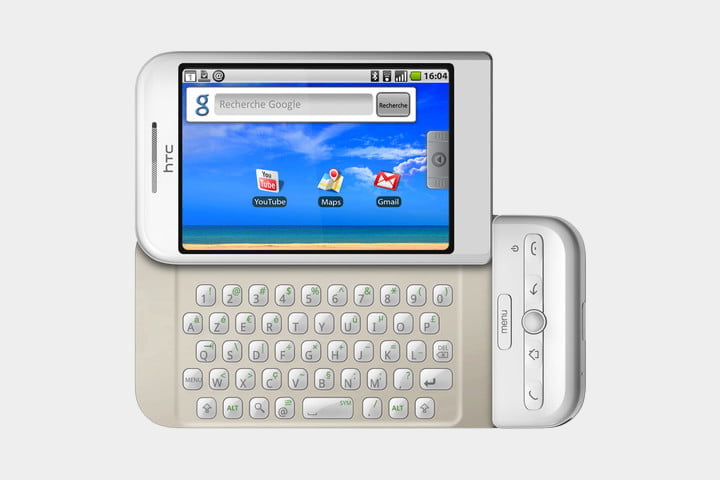The development of the Android operating system began in 2003 by Android, Inc. While the company was working on an early version of Android, Google acquired the company in 2005. The first beta version of Android OS was released on November 5, 2007, and the first phone with Android was released in October 2008. This phone was an HTC-made T-Mobile G1 (aka HTC Dream)
HTC Dream was the first Android phone running Android 1.0. The most notable things were pull-down notifications, Market (Now Play Store), the ability to use home screen widgets, and deep integration with Gmail.
In the past 12 years, after the first commercial Android OS was released, Android has seen several changes and improvements. Major Android update comes once a year, but Google keeps releasing monthly security updates. Sometimes there were bigger updates that weren’t full version releases, but improved the existing version. For example, Android 8.0 to Android 8.1. Before Android 19, Google named each Android after a dessert or some other form of confection. After Android Pie, Google decided to start using numbers to make naming easy. So, the version of Android after Android Pie was called just ‘Android 10’. This naming followed in the future.
Here is the Android Version list. You can use the list to know the name of each Android version and the release date.
Android Versions List
| Android Version Name | Code name | Version numbers | Release date |
|---|---|---|---|
| Android 1.0 | No codename | 1.0 | September 23, 2008 |
| Android 1.1 | Petit Four | 1.1 | February 9, 2009 |
| Android Cupcake | Cupcake | 1.5 | April 27, 2009 |
| Android Donut | Donut | 1.6 | September 15, 2009 |
| Android Eclair | Eclair | 2.0 – 2.1 | October 26, 2009 |
| Android Froyo | Froyo | 2.2 – 2.2.3 | May 20, 2010 |
| Android Gingerbread | Gingerbread | 2.3 – 2.3.7 | December 6, 2010 |
| Android Honeycomb | Honeycomb | 3.0 – 3.2.6 | February 22, 2011 |
| Android Ice Cream Sandwich | Ice Cream Sandwich | 4.0 – 4.0.4 | October 18, 2011 |
| Android Jelly Bean | Jelly Bean | 4.1 – 4.3.1 | July 9, 2012 |
| Android KitKat | Key Lime Pie | 4.4 – 4.4.4 | October 31, 2013 |
| Android Lollipop | Lemon Meringue Pie | 5.0 – 5.1.1 | November 12, 2014 |
| Android Marshmallow | Macadamia Nut Cookie | 6.0 | October 5, 2015 |
| Android Nougat | New York Cheesecake | 7.0 – 7.1 | August 22, 2016 |
| Android Oreo | Oatmeal Cookie | 8.0 – 8.1 | August 21, 2017 |
| Android Pie | Pistachio Ice Cream | 9.0 | August 6, 2018 |
| Android 10 | Quince Tart | 10.0 | September 3, 2019 |
| Android 11 | Red Velvet Cake | 11.0 | September 8, 2020 |
| Android 12 | Snow Cone | 12.0 | October 4, 2021 |
| Android 12L | Snow Cone v2 | 12.1 | March 7, 2022 |
| Android 13 | Tiramisu | 13.0 | August 15, 2022 |
| Android 14 | Upside Down Cake | 14.0 | October 4, 2023 |
| Android 15 | Vanilla Ice Cream | 15.0 | July 18, 2024 |
| Android 16 | Baklava | 16.0 | June 25, 2025 |
Here are a few notable things you should know.
- Andy Rubin is known as the creator of Android. Google bought Android back in 2005 for $50 million.
- Before selling Android to Google, it was offered to Samsung, but Samsung didn’t find Android interesting and rejected the offer.
- The Android project began as an OS for digital cameras and later switched focus to smartphones.
- Initially, there were random updates, but Google started yearly OS version updates starting the Ice Cream Sandwich era.
- Android Honeycomb was the first Android version that was optimized for tablets and ran alongside the Gingerbread build for phones. Later, Google combined both and released Ice Cream Sandwich.
- Ice Cream Sandwich not just combined the tablet and phone versions of Android, but also came with several design changes to improve the Android experience.
- Android’s open-source nature allows for extensive customization. This is the reason smartphone manufacturers create unique user interfaces and experiences.
- Android devices seamlessly integrate with Google services like Gmail, Google Maps, Google Drive, and more.









